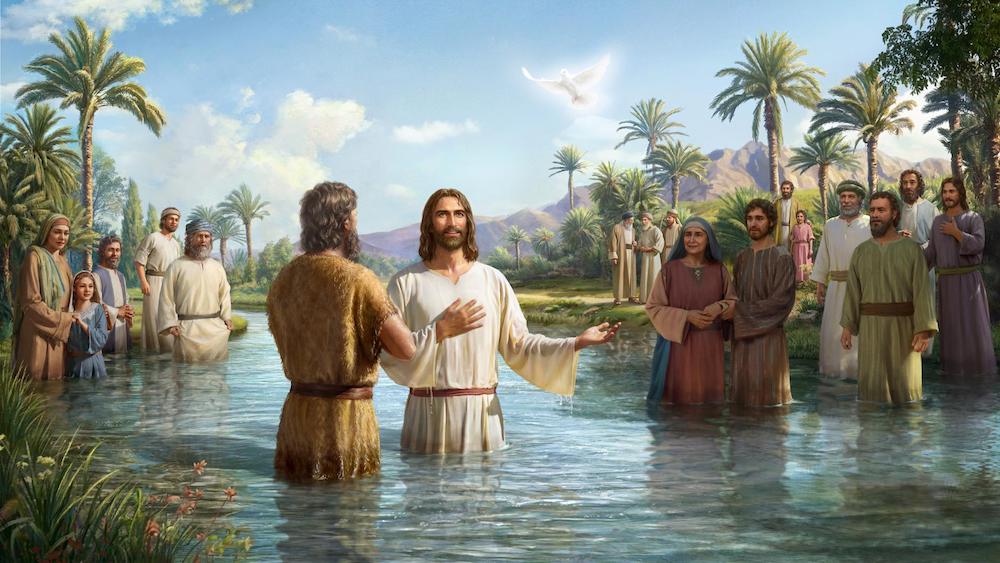Introduction Where Exactly Did John the Baptist Baptize Jesus?
The baptism of Jesus Christ by John the Baptist is one of the most significant events in Christian theology. It marks the beginning of Jesus’ public ministry and is described in the synoptic Gospels of Matthew, Mark, and Luke. But where exactly did this sacred event take place? Understanding the geographical context not only enhances our appreciation of the event but also deepens our understanding of its spiritual and theological implications.
In this article, we will explore the historical, geographical, and scriptural evidence that sheds light on the precise location where John the Baptist baptized Jesus. We will also discuss the significance of the Jordan River and how various Christian traditions view this important site today.
The Biblical Account of Jesus’ Baptism
The baptism of Jesus is mentioned in all four Gospels, but the synoptic Gospels (Matthew, Mark, and Luke) provide more detailed accounts. These descriptions are essential to understanding the location of the baptism and the role it played in Jesus’ life and ministry.
Matthew’s Account
In the Gospel of Matthew (Matthew 3:13-17), we read:

“Then Jesus came from Galilee to the Jordan to be baptized by John. But John tried to deter him, saying, ‘I need to be baptized by you, and do you come to me?’ Jesus replied, ‘Let it be so now; it is proper for us to do this to fulfill all righteousness.’ Then John consented. As soon as Jesus was baptized, he went up out of the water. At that moment heaven was opened, and he saw the Spirit of God descending like a dove and alighting on him. And a voice from heaven said, ‘This is my Son, whom I love; with him, I am well pleased.'”
Matthew’s account gives us a few details: Jesus traveled from Galilee to the Jordan River, where He was baptized by John the Baptist. However, it does not specify the exact location along the river.
Mark’s Account
In Mark 1:9-11, we read:
“At that time Jesus came from Nazareth in Galilee and was baptized by John in the Jordan. Just as Jesus was coming up out of the water, he saw heaven being torn open and the Spirit descending on him like a dove. And a voice came from heaven: ‘You are my Son, whom I love; with you, I am well pleased.’”
Again, the Gospel of Mark provides us with the location of the Jordan River but leaves out specific geographical markers.
Luke’s Account
The Gospel of Luke (Luke 3:21-22) similarly emphasizes the event without giving much detail about the location:
“When all the people were being baptized, Jesus was baptized too. And as he was praying, heaven was opened and the Holy Spirit descended on him in bodily form like a dove. And a voice came from heaven: ‘You are my Son, whom I love; with you, I am well pleased.'”
While the synoptic Gospels give us some key insights into the event, the exact spot along the Jordan River is not identified in these texts. Therefore, we must turn to historical sources, geography, and church tradition to answer the question: Where exactly did John the Baptist baptize Jesus?
The Jordan River: A Sacred Geography
The Jordan River holds profound spiritual significance in both the Old and New Testaments. As a physical boundary between the lands of Israel and modern-day Jordan, the river has been a symbol of new beginnings, transformation, and covenant for centuries.
The Significance of the Jordan River in the Old Testament
Before we delve into the specific location where Jesus was baptized, it’s important to understand the broader significance of the Jordan River in biblical history.
- The Israelites’ Entry into the Promised Land: One of the most notable events involving the Jordan River is the crossing of the Israelites into the Promised Land. According to Joshua 3, the river parted miraculously, allowing the Israelites to cross on dry ground.
- Elijah and Elisha: Another notable Old Testament story involves the prophets Elijah and Elisha. Elijah struck the Jordan River with his cloak, causing it to part (2 Kings 2:8), and this miracle was repeated by Elisha after Elijah’s ascent into heaven.
These events marked Jordan as a place of divine intervention and transformation, making it a fitting location for the baptism of Jesus, which signaled the beginning of His public ministry.
The Role of the Jordan River in the New Testament
In the New Testament, the Jordan River is primarily associated with John the Baptist’s ministry. John baptized many people there, preaching repentance and calling them to prepare for the coming of the Messiah.
In John 1:28, we are given a bit more information about the location of John’s baptisms:
“This all happened at Bethany on the other side of the Jordan, where John was baptizing.”
Here, the Gospel of John provides a specific reference to a place known as “Bethany beyond the Jordan.” This detail is a key clue in determining the location of Jesus’ baptism.
Identifying the Exact Location: Bethany Beyond the Jordan
The phrase “Bethany beyond the Jordan” has been the subject of much debate and research among scholars and archaeologists. The confusion primarily stems from the fact that there are two Bethanys mentioned in the New Testament: one near Jerusalem (the home of Lazarus, Mary, and Martha) and another “beyond the Jordan.”
Bethany Beyond the Jordan in Modern-Day Jordan
Most scholars and Christian traditions now agree that the “Bethany beyond the Jordan” mentioned in John’s Gospel refers to a location on the east bank of the Jordan River, in what is today the Hashemite Kingdom of Jordan. This site, known as Al-Maghtas (Arabic for “the baptism”), has been recognized by many as the authentic location of Jesus’ baptism.
Excavations at Al-Maghtas began in the 1990s, and numerous findings, including Byzantine and Roman ruins, ancient churches, and baptismal pools, support the claim that this was the site where John the Baptist conducted his ministry and where Jesus was baptized.
Archaeological Evidence
The archaeological discoveries at Al-Maghtas provide compelling evidence for its identification as the location of Jesus’ baptism. Key findings include:
- Ancient Churches and Monasteries: Remains of early Christian churches, built to commemorate the baptism of Jesus, have been unearthed at the site. These structures date back to the 5th and 6th centuries, indicating that early Christians venerated this location as the baptismal site.
- Baptismal Pools: Archaeologists have uncovered ancient pools that were likely used for baptismal purposes. These pools were designed to accommodate large numbers of pilgrims, suggesting that the site was an important pilgrimage destination in antiquity.
- Pilgrimage Accounts: Historical accounts from early Christian pilgrims, such as those by the Spanish nun Egeria in the 4th century, describe visiting the site of Jesus’ baptism near the Jordan River, corroborating the archaeological evidence.
The Significance of Bethany Beyond the Jordan
Bethany beyond the Jordan, or Al-Maghtas, holds tremendous religious significance for Christians, and it has been recognized as a UNESCO World Heritage site. Pilgrims from around the world visit the site to commemorate the baptism of Jesus and to be baptized in the waters of the Jordan River themselves.
Alternative Theories and Locations
While Bethany beyond the Jordan is widely accepted as the authentic location of Jesus’ baptism, there are a few other theories and potential sites that have been proposed over the years.
Qasr al-Yahud: The West Bank Site
Another site often associated with Jesus’ baptism is Qasr al-Yahud, located on the west bank of the Jordan River, near Jericho. This site has been a traditional baptismal location for centuries, and it is managed by the Israeli authorities.
Qasr al-Yahud is believed by some to be the place where the Israelites crossed the Jordan River into the Promised Land and where Elijah ascended into heaven. Like Bethany beyond the Jordan, it has historical and spiritual significance, and many pilgrims choose to be baptized here as well.
The Debate: East vs. West Bank
The debate over whether Jesus was baptized on the east or west bank of the Jordan River continues to this day. While the majority of scholars support the east bank (Bethany beyond the Jordan), some argue that the west bank site (Qasr al-Yahud) may also hold validity. Both sites are in close proximity to one another, separated only by the narrow Jordan River, and both hold deep spiritual meaning for Christians.
Theological Significance of Jesus’ Baptism
The precise location of Jesus’ baptism, while important for historical and geographical reasons, holds even greater significance from a theological perspective. Jesus’ baptism marked the beginning of His public ministry and symbolized several key elements of Christian faith.
1. Fulfillment of Righteousness
When John the Baptist expressed reluctance to baptize Jesus, Jesus replied,
“Let it be so now; it is proper for us to do this to fulfill all righteousness”
(Matthew 3:15)
Jesus’ baptism was an act of obedience to the Father and a fulfillment of divine righteousness. It set an example for believers to follow in baptism as a public declaration of faith and repentance.
2. The Revelation of the Trinity
The baptism of Jesus is one of the clearest instances in the New Testament where the three persons of the Trinity are revealed together. The Father speaks from heaven, declaring Jesus as His beloved Son and the Holy Spirit descends upon Jesus in the form of a dove. This event underscores the unity and distinctiveness of the Father, Son, and Holy Spirit in Christian theology.
3. A Symbol of New Creation
Just as the Jordan River symbolized new beginnings in the Old Testament (e.g., the Israelites’ entry into the Promised Land), Jesus’ baptism symbolized the inauguration of a new era in salvation history. His baptism pointed forward to His death, burial, and resurrection, which would bring about a new creation and offer salvation to humanity.
The Jordan River as a Pilgrimage Destination
Today, the Jordan River continues to be a place of pilgrimage for Christians from all over the world. Pilgrims visit both Bethany beyond the Jordan (on the east bank) and Qasr al-Yahud (on the west bank) to commemorate the baptism of Jesus and to experience their own baptisms in the river’s waters.
Both sites offer a profound connection to the biblical narrative and provide an opportunity for spiritual renewal and reflection.
Conclusion
The question of where exactly John the Baptist baptized Jesus has been the subject of much research, debate, and tradition. While the Gospel accounts provide limited geographical details, the identification of Bethany beyond the Jordan (Al-Maghtas) as the most likely location is supported by archaeological evidence, early Christian writings, and modern scholarship.
Whether on the east or west bank of the Jordan River, the baptism of Jesus is a foundational event in Christian theology, marking the beginning of His ministry and the revelation of the Trinity. The Jordan River remains a powerful symbol of new beginnings, transformation, and divine grace, drawing pilgrims from all over the world to its sacred waters.
Through this event, we see Jesus’ profound act of humility and obedience, setting the stage for His mission to bring salvation to humanity. The significance of this event continues to resonate with Christians today, making the Jordan River a place of deep spiritual meaning and pilgrimage.
